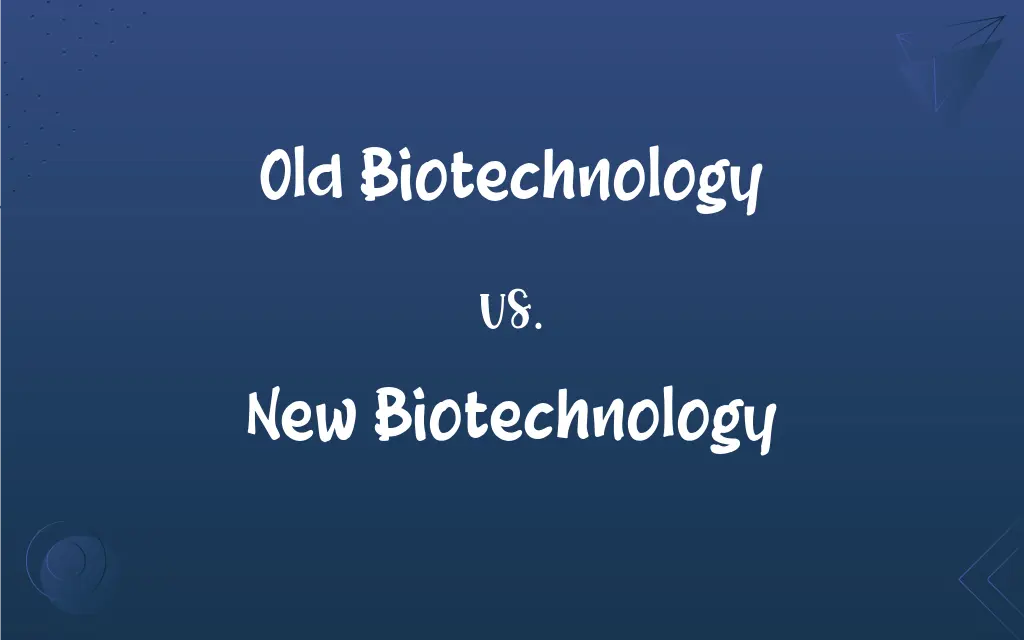Old Biotechnology vs. New Biotechnology: What's the Difference?
Edited by Aimie Carlson || By Harlon Moss || Updated on October 30, 2023
Old biotechnology involves traditional techniques like fermentation and selective breeding; new biotechnology includes modern techniques such as genetic engineering and CRISPR.

Key Differences
Old biotechnology plays an important role in industries like agriculture and food production, where traditional methods like fermentation are still widely used. Similarly, new biotechnology has numerous applications in these industries, but also extends to others like medicine and energy production. In medicine, new biotechnology has paved the way for developments like gene therapy and personalized medicine.
The ethical considerations surrounding old biotechnology are generally less contentious than those surrounding new biotechnology. This is because new biotechnology often involves manipulating DNA and can raise questions about the morality of such interventions. Despite these concerns, new biotechnology holds the potential to address many global challenges, such as hunger and disease.
Both old and new biotechnologies are important in addressing global challenges, but they do so in different ways. Old biotechnology often involves less sophisticated techniques and has a longer history, whereas new biotechnology relies on advanced technology and has emerged more recently. This distinction is crucial to understanding the potential and limitations of each type of biotechnology.
Comparison Chart
Techniques
Fermentation, selective breeding
Genetic engineering, CRISPR
Technology Required
Less sophisticated
Advanced
ADVERTISEMENT
Applications
Agriculture, food production
Medicine, energy production
Ethical Considerations
Generally less contentious
Can be contentious
Impact on Global Challenges
Addresses challenges in traditional ways
Addresses challenges innovatively
Old Biotechnology and New Biotechnology Definitions
Old Biotechnology
Old biotechnology refers to traditional techniques used in agriculture and food production.
The use of fermentation in bread-making is a form of old biotechnology.
New Biotechnology
New biotechnology encompasses advanced technologies used in medicine and energy production.
Synthetic biology is a new biotechnology method used to produce biofuels.
ADVERTISEMENT
Old Biotechnology
Old biotechnology includes practices like selective breeding and fermentation.
Selective breeding of crops is an example of old biotechnology used to improve yield.
New Biotechnology
New biotechnology refers to modern techniques like genetic engineering and CRISPR.
Gene therapy is a form of new biotechnology that can treat genetic disorders.
Old Biotechnology
Old biotechnology is generally less complex than new biotechnology.
The process of making yogurt involves old biotechnology.
New Biotechnology
New biotechnology can raise ethical concerns due to its manipulation of DNA.
The use of genetic engineering to create genetically modified organisms (GMOs) is a form of new biotechnology.
Old Biotechnology
Old biotechnology encompasses methods that have been used for thousands of years.
The use of yeast in brewing beer is an ancient form of old biotechnology.
New Biotechnology
New biotechnology has the potential to address global challenges like hunger and disease.
Personalized medicine, a form of new biotechnology, can provide targeted treatments based on a patient's genetic makeup.
Old Biotechnology
Old biotechnology often does not require advanced technology.
Traditional cheese-making is a form of old biotechnology.
New Biotechnology
New biotechnology relies heavily on scientific research and innovation.
CRISPR technology is a new biotechnology tool used for precise gene editing.
FAQs
What is old biotechnology?
Old biotechnology refers to traditional methods such as fermentation and selective breeding.
What are some applications of new biotechnology?
Applications of new biotechnology include medicine and energy production.
What are some applications of old biotechnology?
Applications of old biotechnology include agriculture and food production.
What are genetically modified organisms (GMOs)?
GMOs are organisms that have been genetically altered using new biotechnology methods.
What is the difference between traditional and modern biotechnology?
Traditional biotechnology is synonymous with old biotechnology, while modern biotechnology is synonymous with new biotechnology.
How does old biotechnology differ from new biotechnology?
Old biotechnology involves traditional methods, while new biotechnology includes modern, more complex techniques.
How does old biotechnology impact global challenges?
Old biotechnology addresses global challenges in traditional ways.
How does new biotechnology impact global challenges?
New biotechnology has the potential to address global challenges innovatively.
What is an example of new biotechnology in medicine?
Gene therapy is an example of new biotechnology in medicine.
What is CRISPR?
CRISPR is a new biotechnology tool used for precise gene editing.
What is personalized medicine?
Personalized medicine is a form of new biotechnology that provides targeted treatments based on a patient's genetic makeup.
What is new biotechnology?
New biotechnology refers to modern methods like genetic engineering and CRISPR.
What are the ethical considerations surrounding old biotechnology?
The ethical considerations surrounding old biotechnology are generally less contentious.
What technology is required for old biotechnology?
Old biotechnology requires less sophisticated technology.
What is synthetic biology?
Synthetic biology is a new biotechnology method used to produce biofuels.
What technology is required for new biotechnology?
New biotechnology requires advanced technology.
What is selective breeding?
Selective breeding is a method of old biotechnology used to improve crop yield.
What is genetic engineering?
Genetic engineering is a method of new biotechnology used to modify an organism's DNA.
What is an example of old biotechnology in food production?
Fermentation in bread-making is an example of old biotechnology in food production.
What are the ethical considerations surrounding new biotechnology?
New biotechnology can raise ethical concerns due to its manipulation of DNA.
About Author
Written by
Harlon MossHarlon is a seasoned quality moderator and accomplished content writer for Difference Wiki. An alumnus of the prestigious University of California, he earned his degree in Computer Science. Leveraging his academic background, Harlon brings a meticulous and informed perspective to his work, ensuring content accuracy and excellence.
Edited by
Aimie CarlsonAimie Carlson, holding a master's degree in English literature, is a fervent English language enthusiast. She lends her writing talents to Difference Wiki, a prominent website that specializes in comparisons, offering readers insightful analyses that both captivate and inform.
































































